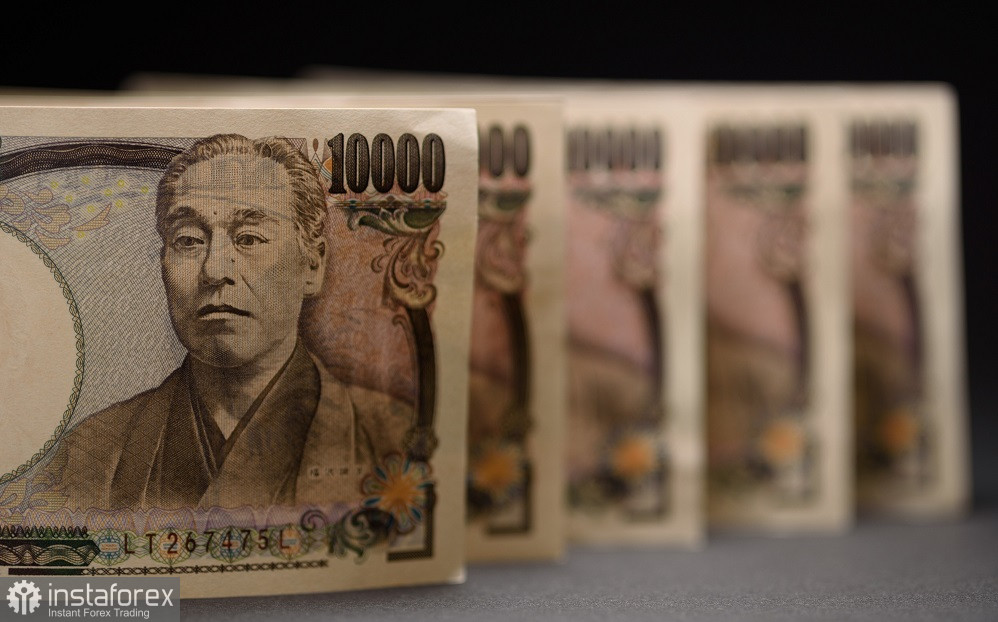The USD/JPY pair, after prolonged deliberation, has finally decided to storm the 149th figure. This followed weeks of siege, so the current upward impulse should be viewed as reconnaissance in force.

However, it is necessary to acknowledge that bullish sentiments still dominate the pair: the dollar maintains its positions, while the yen is under background pressure from the Japanese regulator. Traders' hope for revolutionary changes in the Bank of Japan's policy dwindled at the end of December when the USD/JPY pair was at the base of the 140 figure. Since then, the yen has depreciated by more than 800 points.
The target of 149.00 (upper line of the Bollinger Bands indicator on the four-hour chart) unexpectedly proved to be a strong resistance level – in essence, the 800-point dash was halted in this price area. Therefore, opening long positions on the pair is advisable only when USD/JPY buyers establish themselves in the 149 region, overcoming the next price barrier at 149.40 (upper Bollinger Bands line on the daily chart). Such a development is highly likely. Why?
Here, it is essential to answer another question – why exactly did the Japanese currency depreciate so actively throughout January? The answer is known: due to the decoupling of the exchange rates of the Federal Reserve and the Bank of Japan. At the end of last year, the market was abuzz with rumors that the Japanese central bank was preparing to normalize monetary policy and would soon abandon negative rates. These rumors were fueled by the bank itself, represented by Chairman Kazuo Ueda.
In December, Ueda informed parliamentarians that the central bank was considering various target interest rate options after exiting the negative rate policy. According to him, the regulator could either maintain the interest rate applied to reserves or return to a policy focused on the overnight rate. After this statement, there were discussions in the market that the Bank of Japan would change its course almost at the next meeting.
Simultaneously, the December meeting of the Federal Reserve took place, the dovish results of which literally shocked market participants. The regulator noticeably softened the wording of the accompanying statement, and Fed Chairman Jerome Powell unmistakably indicated that from the next meeting, the Federal Reserve would discuss easing monetary policy.
Such an information background allowed USD/JPY bears to update a 5-month price low, reaching the 140.25 mark.
But already in January, the situation changed dramatically. The Bank of Japan distanced itself from any changes in the foreseeable future, while the Federal Reserve significantly lowered expectations for imminent monetary policy easing. Now, these fundamental factors, so to speak, are "revealing themselves" through the dovish rhetoric of representatives of the Japanese regulator and hawkish remarks from the Federal Reserve.
Thursday's upward impulse was triggered by Bank of Japan Deputy Governor Shinichi Uchida, who said that the central bank plans to maintain a "stable, accommodative monetary environment," and even if negative rates are canceled, accommodative conditions will still be preserved. However, Uchida did not specify any time frames. He only noted that the future path of rates depends on the development of the economy and prices: "First, we will determine whether the conditions for changing monetary policy have arisen, and then consider the most suitable means and sequence of actions."
Recall that following the January meeting of the Bank of Japan, Ueda hinted that any discussions on tweaking the monetary policy could only take place after the "spring offensives," i.e., after the annual wage negotiations between unions and businesses. According to some estimates, the probability that the regulator will deem these negotiations "successful" does not exceed 30%. In particular, this was stated by former Bank of Japan board member Momma Kazuo.
Such an information background contributes to further weakening of the yen, especially when paired with the greenback, whose ally is the Federal Reserve. Representatives of the Federal Reserve noticeably tightened their rhetoric in January in response to the rise in overall inflation, strong Nonfarm Payrolls, and the growth of the U.S. economy.
On Wednesday, Federal Reserve Board Member Adriana Kugler stated that only a cooling of inflation and the labor market "could make a rate cut appropriate." However, if the pace of disinflation slows down, the regulator will be forced to keep the rate at the current level and beyond. A similar position was voiced earlier by many other representatives of the Federal Reserve, including Jerome Powell.
Thus, the decoupling of positions between the Federal Reserve and the Bank of Japan will continue to push the pair higher – up to "dangerous levels," that is, up to the 151 figure. This is a kind of red line, the intersection of which could lead to consequences in the form of currency intervention.
As mentioned earlier, it is advisable to open long positions after USD/JPY buyers overcome the resistance level of 149.40 (upper Bollinger Bands line on the daily chart). The main targets for the upward movement are the levels of 150.50 and 151.00.





















